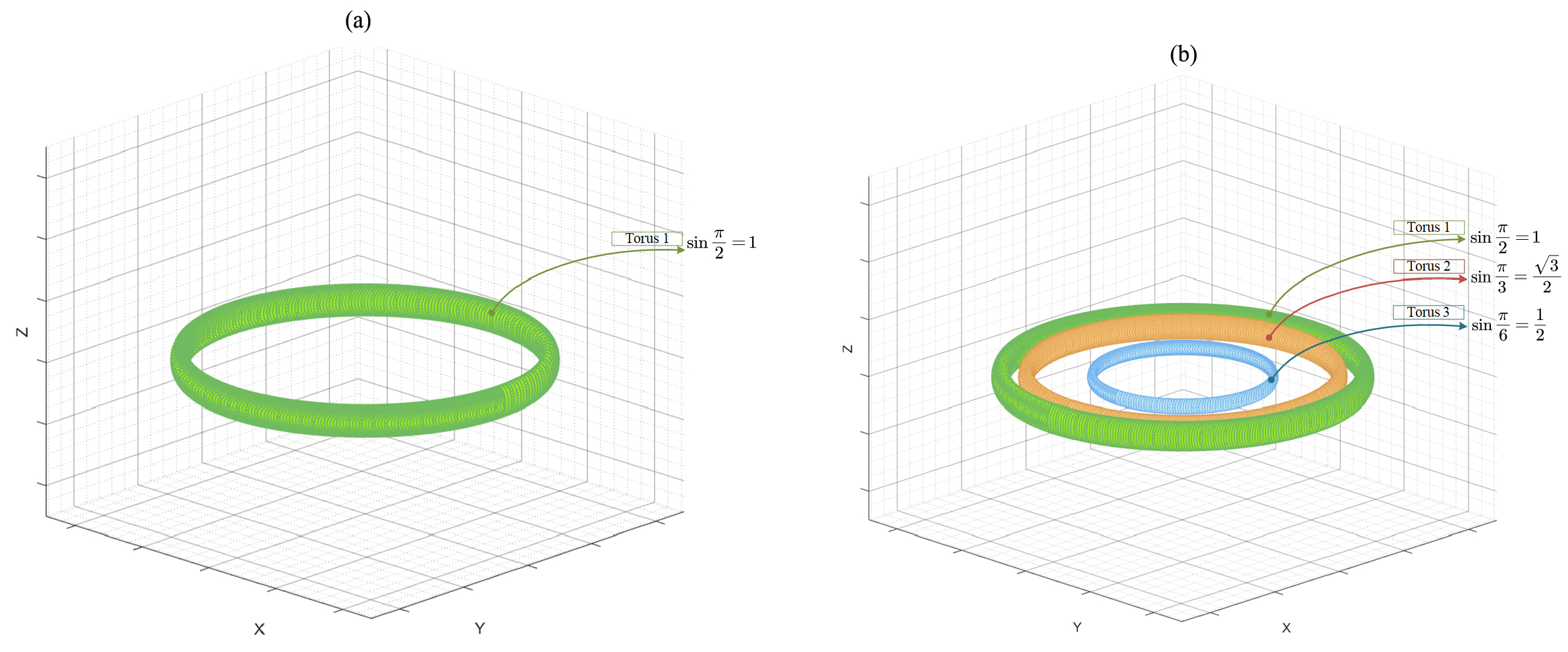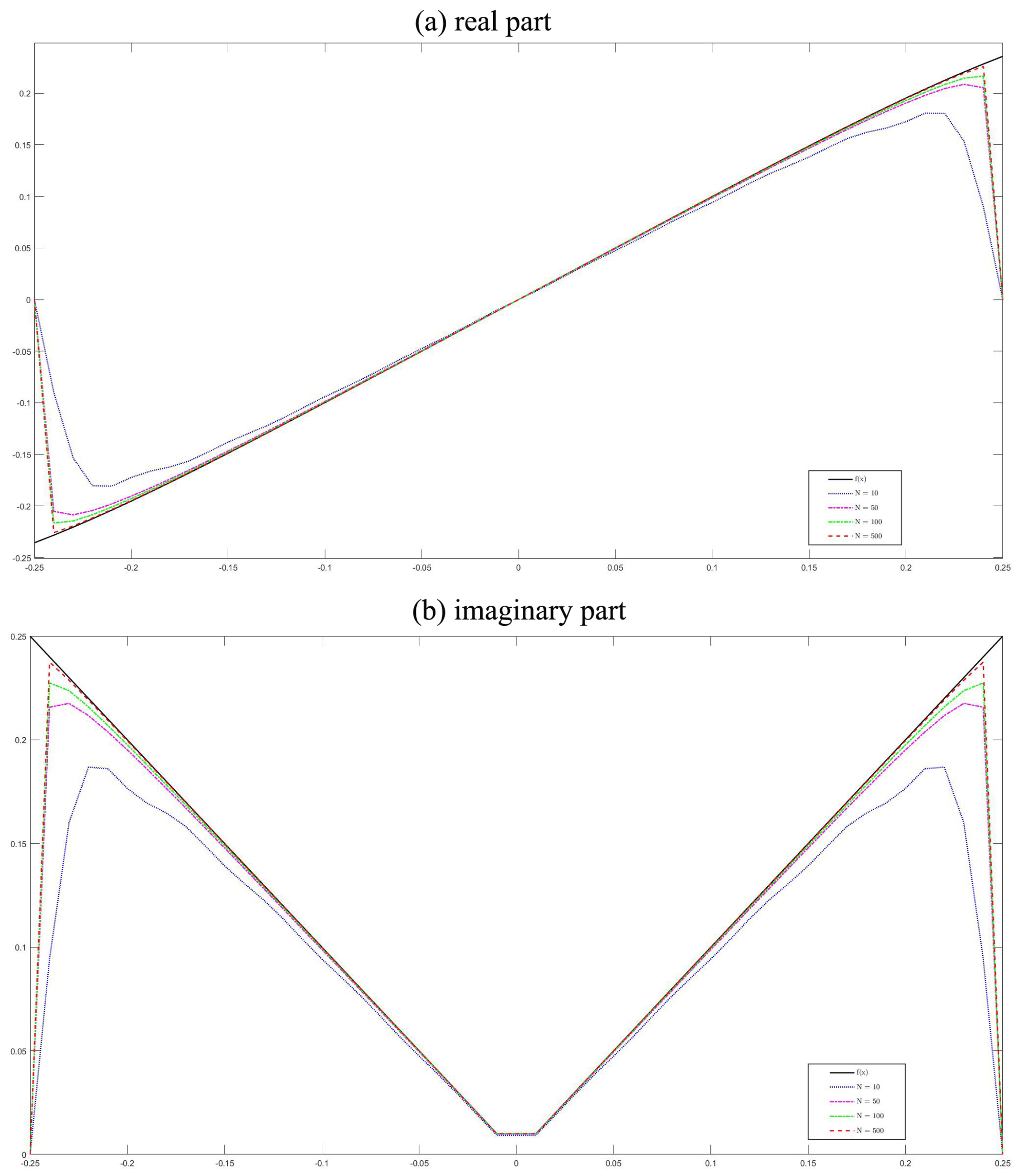Fractional Fourier Series on the Torus and Applications
Abstract
1. Introduction
2. Fractional Fourier Series on the Torus
- 1.
- ;
- 2.
- ;
- 3.
- ;
- 4.
- ;
- 5.
- ;
- 6.
- ;
- 7.
- ;
- 8.
- ;
- 9.
- whenever .
- (1)
- If , , then
- (2)
- If is uniformly continuous on a subset K of , then
3. Reproduction of Functions from Their Fractional Fourier Coefficients
3.1. Fractional Fourier Inversion
3.2. Fractional Fourier Series of Square Summable Functions
- (1)
- (Plancherel’s identity)
- (2)
- The function is almost everywhere equal to the limit of the sequence
- (3)
- (Parseval’s relation)
- (4)
- The map is an isometry from onto .
- (5)
- For all , we have
3.3. The Fractional Poisson Summation Formula
4. Decay of Fractional Fourier Coefficient
4.1. Decay of Fractional Fourier Coefficients of Integrable Function
4.2. Decay of Fractional Fourier Coefficients of Smooth Functions
- (a)
- Let . Then,and thus,as .
- (b)
- Suppose that and whenever , are in for some . Then,
- (a)
- Let . Then,
- (b)
- Suppose that and whenever , are in for some . Then,
5. Convergence of Fractional Fourier Series
5.1. Almost Everywhere Convergence of Fractional Fejér Means
- (a)
- LetThen, maps to and to for , where
- (b)
- For any function , we obtain that as
5.2. Norm Convergence of the Fractional Bochner–Riesz Means
- (1)
- For every , there exists constant such that when ;
- (2)
- There exists constant such that , ∀ and ;
- (3)
- for all .
6. Applications to Partial Differential Equations
7. Applications to Non-Stationary Signals
Author Contributions
Funding
Data Availability Statement
Conflicts of Interest
References
- Dirichlet, G.L. Sur la convergence des séries trigonomtriques qui serventà reprsenter une fonction arbitraire entre des limites donneés. J. Reine Angew. Math. 1829, 4, 157–169. [Google Scholar]
- van Putten, M.H.P.M. Superradiance in a torus magnetosphere around a black hole. Science 1999, 284, 115–118. [Google Scholar] [CrossRef] [PubMed]
- Kolmogorov, A. Une série de Fourier-Lebesgue divergente presque partout. Fund. Math. 1923, 4, 324–328. [Google Scholar] [CrossRef]
- Kolmogorov, A. Une série de Fourier-Lebesgue divergente partout. C. R. Acad. Sci. Paris 1926, 183, 1327–1328. [Google Scholar] [CrossRef]
- Carleson, L. On convergence and growth of partial sums of Fourier series. Acta Math. 1966, 116, 135–157. [Google Scholar] [CrossRef]
- Hunt, R. On the Convergence of Fourier Series; Orthogonal Expansions and Their Continuous Analogues (Proc. Conf., Edwardsville, IL, 1967); Southern Illinois University Press: Carbondale, IL, USA, 1968; pp. 235–255. [Google Scholar]
- Fefferman, C. Pointwise convergence of fourier series. Ann. Math. 1973, 98, 551–571. [Google Scholar] [CrossRef]
- Lacey, M.; Thiele, C. A proof of boundedness of the Carleson operator. Math. Res. Lett. 2000, 7, 361–370. [Google Scholar] [CrossRef]
- de Lessa Victor, B. Fourier analysis for Denjoy-Carleman classes on the torus. Ann. Fenn. Math. 2021, 46, 869–895. [Google Scholar] [CrossRef]
- Grafakos, L. Classical Fourier Analysis; Graduate Texts in Mathematics, 249; Springer: New York, NY, USA, 2014. [Google Scholar]
- Hytönen, T.; Lacey, M. Pointwise convergence of vector-valued Fourier series. Math. Ann. 2013, 357, 1329–1361. [Google Scholar] [CrossRef]
- Marcinkiewicz, J.; Zygmund, A. On the summability of double Fourier series. Fund. Math. 1939, 32, 122–132. [Google Scholar] [CrossRef]
- Wiener, N. Hermitian polynomials and Fourier analysis. J. Math. Phys. 1929, 8, 70–73. [Google Scholar] [CrossRef]
- Namias, V. The fractional order Fourier transform and its application to quantum mechanics. IMA J. Appl. Math. 1980, 25, 241–265. [Google Scholar] [CrossRef]
- McBride, A.C.; Kerr, F.H. On Namias’s fractional Fourier transforms. IMA J. Appl. Math. 1987, 39, 159–175. [Google Scholar] [CrossRef]
- Kerr, F. Namias’ fractional Fourier transforms on L2 and applications to differential equations. J. Math. Anal. Appl. 1988, 136, 404–418. [Google Scholar] [CrossRef]
- Zayed, A. A convolution and product theorem for the fractional Fourier transform. IEEE Signal Proc. Lett. 1998, 5, 101–103. [Google Scholar] [CrossRef]
- Zayed, A. A class of fractional integral transforms: A generalization of the fractional Fourier transform. IEEE Trans. Signal Process. 2002, 50, 619–627. [Google Scholar] [CrossRef] [PubMed]
- Zayed, A. Two-dimensional fractional Fourier transform and some of its properties. Integral Transform. Spec. Funct. 2018, 29, 553–570. [Google Scholar] [CrossRef]
- Kamalakkannan, R.; Roopkumar, R. Multidimensional fractional Fourier transform and generalized fractional convolution. Integral Transform. Spec. Funct. 2020, 31, 152–165. [Google Scholar] [CrossRef]
- Chen, W.; Fu, Z.; Grafakos, L.; Wu, Y. Fractional Fourier transforms on Lp and applications. Appl. Comput. Harmon. Anal. 2021, 55, 71–96. [Google Scholar] [CrossRef]
- Fu, Z.; Grafakos, L.; Lin, Y.; Wu, Y.; Yang, S. Riesz transform associated with the fractional Fourier transform and applications in image edge detection. Appl. Comput. Harmon. Anal. 2023, 66, 211–235. [Google Scholar] [CrossRef]
- Fu, Z.; Lin, Y.; Yang, D.; Yang, S. Fractional Fourier transforms meet Riesz potentials and image processing. SIAM J. Imaging Sci. 2024, 17, 476–500. [Google Scholar] [CrossRef]
- Ozaktas, H.M.; Zalevsky, Z.; Kutay Alper, M. The Fractional Fourier Transform: With Applications in Optics and Signal Processing; Wiley: New York, NY, USA, 2001. [Google Scholar]
- Pei, S.; Yeh, M.; Luo, T. Fractional Fourier series expansion for finite signals and dual extension to discrete-time fractional Fourier transform. IEEE Trans. Signal Process. 1999, 47, 2883–2888. [Google Scholar]
- Tao, R.; Deng, B.; Zhang, W.; Wang, Y. Sampling and sampling rate conversion of band limited signals in the fractional Fourier transform domain. IEEE Trans. Signal Process. 2008, 56, 158–171. [Google Scholar] [CrossRef]
- Liu, S.; Ren, H.; Zhang, J.; Zhang, X. Image-scaling problem in the optical fractional Fourier transform. Appl. Opt. 1997, 36, 5671–5674. [Google Scholar] [CrossRef]
- Lang, J.; Tao, R.; Wang, Y. Image encryption based on the multiple-parameter discrete fractional Fourier transform and chaos function. Opt. Commun. 2010, 283, 2092–2096. [Google Scholar] [CrossRef]
- Yang, Y.; Wu, Q.; Jhang, S.; Kang, Q. Approximation theorems associated with multidimensional fractional Fourier transform and applications in Laplace and heat equations. Fractal. Fract. 2022, 6, 625. [Google Scholar] [CrossRef]
- Yang, Y.; Wu, Q.; Jhang, S. 2D linear canonical transforms on Lp and applications. Fractal Fract. 2023, 7, 100. [Google Scholar] [CrossRef]
- Li, G.; Li, J. The boundedness of the bilinear oscillatory integral along a parabola. Proc. Edinb. Math. Soc. 2023, 66, 54–88. [Google Scholar] [CrossRef]
- Li, B.; Fan, X.; Fu, Z.; Yang, D. Molecular characterization of anisotropic Musielak-Orlicz Hardy spaces and their applications. Acta Math. Sin. (Engl. Ser.) 2016, 32, 1391–1414. [Google Scholar] [CrossRef]
- Wu, Q.; Fu, Z. Sharp estimates for Hardy operators on Heisenberg group. Front. Math. China 2016, 11, 155–172. [Google Scholar] [CrossRef]
- Bochner, S. Summation of multiple Fourier series by spherical means. Trans. Amer. Math. Soc. 1936, 40, 175–207. [Google Scholar] [CrossRef]
- Fan, D.; Zhao, F. Block-Sobolev spaces and the rate of almost everywhere convergence of Bochner-Riesz means. Constr. Approx. 2017, 45, 391–405. [Google Scholar] [CrossRef]
- Shi, S. Some notes on supersolutions of fractional p-Laplace equation. J. Math. Anal. Appl. 2018, 463, 1052–1074. [Google Scholar] [CrossRef]
- Shi, S.; Zhang, L. Dual characterization of fractional capacity via solution of fractional p-Laplace equation. Math. Nachr. 2020, 293, 2233–2247. [Google Scholar] [CrossRef]
- Shi, S.; Zhang, L.; Wang, G. Fractional non-linear regularity potential and balayage. J. Geom. Anal. 2022, 32, 221. [Google Scholar] [CrossRef]


Disclaimer/Publisher’s Note: The statements, opinions and data contained in all publications are solely those of the individual author(s) and contributor(s) and not of MDPI and/or the editor(s). MDPI and/or the editor(s) disclaim responsibility for any injury to people or property resulting from any ideas, methods, instructions or products referred to in the content. |
© 2024 by the authors. Licensee MDPI, Basel, Switzerland. This article is an open access article distributed under the terms and conditions of the Creative Commons Attribution (CC BY) license (https://creativecommons.org/licenses/by/4.0/).
Share and Cite
Wang, C.; Hou, X.; Wu, Q.; Dang, P.; Fu, Z. Fractional Fourier Series on the Torus and Applications. Fractal Fract. 2024, 8, 494. https://doi.org/10.3390/fractalfract8080494
Wang C, Hou X, Wu Q, Dang P, Fu Z. Fractional Fourier Series on the Torus and Applications. Fractal and Fractional. 2024; 8(8):494. https://doi.org/10.3390/fractalfract8080494
Chicago/Turabian StyleWang, Chen, Xianming Hou, Qingyan Wu, Pei Dang, and Zunwei Fu. 2024. "Fractional Fourier Series on the Torus and Applications" Fractal and Fractional 8, no. 8: 494. https://doi.org/10.3390/fractalfract8080494
APA StyleWang, C., Hou, X., Wu, Q., Dang, P., & Fu, Z. (2024). Fractional Fourier Series on the Torus and Applications. Fractal and Fractional, 8(8), 494. https://doi.org/10.3390/fractalfract8080494




